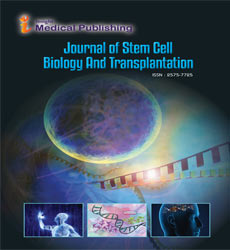ISSN : 2575-7725
Journal of Stem Cell Biology and Transplantation
Ex-vivo exposure to a small molecule, enhances migration and homing of murine Hematopoietic stem and progenitor cells
1 Drug Repurposing and Translational Research Lab, Institute of Nuclear Medicine and Allied Sciences, DRDO, New Delhi, India
2 Department of Zoology, University of Delhi, New Delhi, India
- *Corresponding Author:
- Anoushka Khanna
Drug Repurposing and Translational Research Lab, Institute of Nuclear Medicine and Allied Sciences, DRDO, New Delhi, India
Email: khanna.anoushka225@gmail.com
Received: July 23, 2020; Accepted: July 30, 2020; Published: August 3,2020
Citation: Anoushka Khanna(2020), Ex-vivo exposure to a small molecule, enhances migration and homing of murine Hematopoietic and stem and progenitor cells J Stem Cell Biol Transplant Vol.4 No.3:28.
Abstract
Acute Radiation Syndrome (ARS) or sickness occurs after a wholebody exposure to a high dose of ionising radiation over a short time frame. This type of acute exposure is often associated with accidental exposure as in the case of atomic bomb survivors, nuclear radiation accident victims and sometimes planned exposure like radiation therapy patients. Based on the differences in the cellular sensitivity to Ionising radiation, ARS is broadly divided into hematopoietic (Bone marrow syndrome), gastrointestinal, and neurovascular syndrome. Thus, the amount of radiation dose absorbed by the body, determines the severity of symptoms and the type of ARS. Additionally, ARS manifest in 4 stages, namley Prodromal, Latent, Manifest illness, Recovery or death stage.
Keywords
Hematopoietic stem cells, CXCR4 expression, migration, Homing, SDF-1α.
Introduction
Hematopoietic stem and progenitor cells (HSPCs) are the key regulators of hematopoiesis which give rise to different, mature and committed lineages. Exposure to acute dose of 2.5-5 Gy wholebody radiation results in the loss of HSPCs leading to the inability of the system to generate differentiated lineages which ultimately cause hematopoietic form of acute radiation syndrome (hs-ARS). Lymphocytes, granulocytes and platelets are the first to decline and are considered most radiosensitive. The prodromal stage occurs within a few hours and lasts upto 2 days. Hallmark symptoms involve nausea and vomiting, followed by a latent stage where no visible symptoms appear and the patient shows clinical improvement and may feel well, although the bone marrow cells are dying simultaneously. This stage lasts for 1-6 weeks. This is followed by the Manifest illness stage where the symptoms reappear. The circulating blood cells drop for several weeks. The primary cause of death is infection and haemorrhage (as the platelet number declines, the body losses the clotting ability). Finally arrives the recovery or death stage and depending upon the dose absorbed and radiation induced damage, at low doses, the surviving bone marrow cells may repopulate and lead to full recovery. On the other hand if the dose is high, it may lead to death.
Currently no safe and effective molecule as a radiation countermeasure is available for human applications. Due to this bone marrow transplantation (BMT) has become an indispensable strategy for the management of radiation over-exposed victims, hematopoietic malignancies and planned chemotherapy induced bone marrow depression. Several strategies have been employed to achieve successful Hematopoietic stem cell transplantation (HSCT), capable of enhancing HSC homing and engraftment potential but at a high cost. Here in this study, we have reported an inexpensive strategy involving ex-vivo exposure of murine bone marrow mononuclear cells (BMMNCs) to a small molecule which successfully enhances the HSPC migration and homing to its BM niche after transplantation.
α- chemokine receptor SDF-1α is expressed by the cells lining the bone marrow whereas CXCR4 is expressed on HSPCs. The chemoattraction between SDF-1α and CXCR4 guides the transplanted stem cells from the circulation to the bone marrow niche. Results indicate that ex-vivo exposure led to a significant increase in CXCR4 expression and migration of HSPCs towards SDF-1α as evident from in-vitro studies. In-vivo data displayed that ex-vivo exposure of BMMNCs with the molecule resulted in a significant increase in the number of homed cells to the BM niche as compared to the vehicle treated group. Along with it, the treatment strategy also led to a significant increase in the CXCR4 expression in the homed cells. Hence, the above potential strategy may suggest an efficient and cost-effective method for achieving successful HSC transplantation for a variety of scenarios including management of hs-ARS.
References
- Lopez M, Martín M. Medical management of the acute radiation syndrome. Rep Pract Oncol Radiother. 2011;16(4):138-146. Published 2011 Jul 13. doi:10.1016/j.rpor.2011.05.001
- Donnelly EH, Nemhauser JB, Smith JM, et al. Acute radiation syndrome: assessment and management. South Med J. 2010;103(6):541-546. doi:10.1097/SMJ.0b013e3181ddd571
- Bryder, D., Rossi, D. J., & Weissman, I. L., 2006. Hematopoietic stem cells: the paradigmatic tissue-specific stem cell. The American journal of pathology, 169(2), 338–346.
- Shao, L., Luo, Y., & Zhou, D., 2014. Hematopoietic stem cell injury induced by ionizing radiation. Antioxidants & redox signalling, 20(9), 1447–1462.
Open Access Journals
- Aquaculture & Veterinary Science
- Chemistry & Chemical Sciences
- Clinical Sciences
- Engineering
- General Science
- Genetics & Molecular Biology
- Health Care & Nursing
- Immunology & Microbiology
- Materials Science
- Mathematics & Physics
- Medical Sciences
- Neurology & Psychiatry
- Oncology & Cancer Science
- Pharmaceutical Sciences
